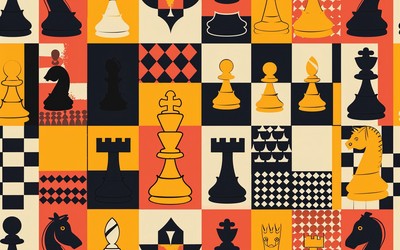
dall-e
Creativity in Training
Ideas from two very different adult improversWhen Matthew Sadler returned to competitive chess in 2010 after a ten year layoff, the odds were stacked against him. At 36, he was at an age where most players are struggling to maintain their rating, let alone increase it. And starting from a rating of 2617 he was facing a steep hill to climb. There are no easy points at that level.
Yet he was explosively successful. He started with 7/7 in a rapid tournament in Holland, then went on to scores of 8.5/10 and 8.5/9 in international tournaments in Barcelona and Oslo, competing against grandmasters. He is now close to 2700 “super grandmaster” status, while still working a (non-chess) job.
How did he do it? He credits much of his success to innovative ways of working with engines. Sadler has a lot of interesting ideas in this area, but a simple one that I like is to play practice games against Leela on one node. In computer chess jargon, “nodes” refers to the number of positions the engine has looked at. Limiting Leela to one node prevents it from doing any calculation at all: it plays on pure “intuition.”
The value of this setting is that it provides a training partner that plays natural, “human” moves, and is strong but not unbeatable. In contrast, other engines on lower strength settings often intersperse strong play with random blunders that are not the sort humans would make. By playing against Leela on one node you get a better sense of what it would be like to play the position against a human.
It’s a very simple technique, yet not one that I had ever heard of before. If you want to try this technique, there are instructions for setting up Leela in the “supplementary material” link on the website for Sadler’s book The Silicon Road to Chess Improvement.
Kamryn Hellman has a very different chess journey than Sadler. Whereas Sadler grew up playing chess, Hellman didn’t start playing until age 21. When you look at players who make tremendous progress “starting” as adults, it often turns out they actually played as kids, just not as seriously. But Hellman was literally learning the rules as an adult. Nonetheless, she got to over 2000 Chess.com rapid in two years.
Like Sadler, she developed her own techniques for training. One that I particularly like is maintaining a “Why I’m Losing” document. It’s simply a Word document with a few bullet points for the key reasons for each game you lose. Like training against Leela on one node, the core idea is simple, but not something that most people do.
What I like about this idea is that it provides a framework for looking for patterns across multiple games. Many players look for mistakes within each game, but it’s more impactful to look for patterns across multiple games. Often, it turns out that many of your mistakes are actually variations on the same weakness or error, but you need to take a step back to see it. The “Why I’m Losing” doc provides a simple reminder and template to accomplish this.
As a chess coach and writer, I’m interested in the key ingredients for improvement. What allows some players to improve rapidly, while others stagnate? Despite having very different chess journeys, I noticed that Sadler and Hellman had several big things in common.
- Taking ownership over the learning process. There are a lot of resources out there for chess improvement in the form of books, courses, coaches, and so on. These can all be helpful if used properly, but they should also be taken with a grain of salt. At the end of the day, you know yourself better than anyone, and only you can ultimately be responsible for your own improvement.
- Creativity in training. To the extent that we think about creativity at all in chess, it’s usually in the form of a creative or unexpected move. But creativity is equally important in training. Both Sadler and Hellman were continuously experimenting with different kinds of training. They both landed on training methods that were simple, effective, yet not widely used.
- Comfort with mistakes. Both of the training methods in this post require you to be comfortable with making mistakes. Playing against the computer – even a weakened computer – will result in losing a lot of games and having your mistakes exposed. And a “Why I’m Losing” doc is of course all about cataloging mistakes. To improve on your mistakes, you have to be comfortable enough to acknowledge them.
- Love for the game. One thing that comes through on both of their respective YouTube channels is just how much they enjoy chess. At the end of the day, this is the biggest competitive advantage of all because it means you’ll be more focused, more engaged, and better equipped to deal with setbacks.
If you liked this check out my newsletter where I write weekly posts about chess, learning, and data: https://zwischenzug.substack.com/




